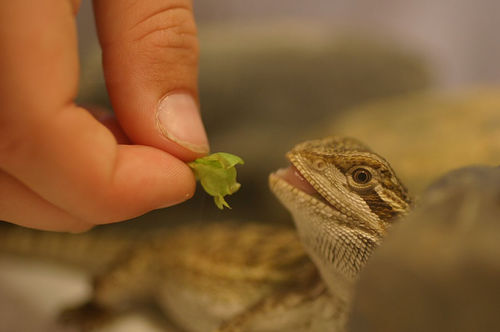The Ultimate Guide on How to Properly Care for Your Bearded Dragon
Introduction
Bearded dragons are one of the most popular lizards kept as pets. They are docile, friendly, and easy to care for, making them an excellent choice for beginner reptile owners. Despite their easy-going nature, proper care for a bearded dragon is still essential to keep them happy and healthy. In this guide, we will provide you with all the information you need to ensure that your bearded dragon enjoys a long and healthy life under your care.
Habitat Setup
The first step in caring for your bearded dragon is setting up an appropriate habitat for it to live in. A bearded dragon needs a spacious enclosure that will allow it to move around comfortably. A 40-gallon tank is the minimum size recommended for a bearded dragon, but a larger enclosure is always better. You will also need to provide the following:
- A basking spot with a temperature of 100-110 degrees Fahrenheit. This can be achieved with a heat lamp or a ceramic heat emitter.
- A cooler area on the opposite side of the enclosure with a temperature of 80-85 degrees Fahrenheit.
- A UVB light that provides your bearded dragon with essential vitamin D3. This light should be replaced every six months.
- Substrate, such as reptile carpet, paper towels, or tile.
- Hides and climbing structures for your bearded dragon to make it feel secure.
- A shallow dish of water for drinking and soaking.
- Heat lamps or ceramic heat emitters should be turned off at night, as bearded dragons require a temperature drop to simulate their natural environment.

Feeding
Bearded dragons are omnivores, meaning they eat both plant and animal matter. A balanced diet for your bearded dragon should consist of the following:
- Insects, such as crickets, mealworms, or dubia roaches.
- Leafy greens, such as collard greens, mustard greens, or kale. Avoid feeding spinach or lettuce, as they are high in oxalates, which can bind calcium and cause health problems.
- Fruits, such as apples, blueberries, or mango. These should be offered as an occasional treat due to their high sugar content.
Bearded dragons should be fed once a day, with insects making up approximately 70% of their diet. The size of the prey should not exceed the width of their head. Juvenile bearded dragons may require an additional feeding per day, while adult bearded dragons may only require feeding every other day.

Health and Hygiene
A healthy bearded dragon should have bright, clear eyes, smooth skin, and a fat tail. If you notice any of the following symptoms, you should consult a veterinarian:
- Lethargy or lack of appetite
- Runny stool or diarrhea
- Discharge from the nose or mouth
- Swollen limbs or joints
- Black discoloration on the skin
Bearded dragons also require regular hygiene maintenance to prevent illness. This includes:
- Cleaning their enclosure at least once per week, including changing the substrate and disinfecting any objects
- Providing fresh water daily and cleaning the water dish regularly
- Handling your bearded dragon regularly to check for signs of illness or injury

Handling and Socialization
Bearded dragons are social creatures that enjoy being handled by their owners. However, it’s essential to handle them correctly to prevent injury. Here are some tips for handling your bearded dragon:
- Support their entire body when picking them up
- Avoid holding them by the tail, as it can break off
- Never squeeze or restrain them, as this can cause stress
- Allow them to explore and climb on you while supervising to prevent falls
Handling your bearded dragon regularly will also help them become more comfortable with you and prevent them from becoming aggressive. It’s also an excellent opportunity to bond with your pet.
Conclusion
Bearded dragons are fascinating creatures that make fantastic pets. With proper care and attention, they can live a long and healthy life. Remember to provide them with a comfortable habitat, a balanced diet, and regular hygiene maintenance. Handle them with care and socialize with them, and you’ll have a happy and friendly companion for years to come.
